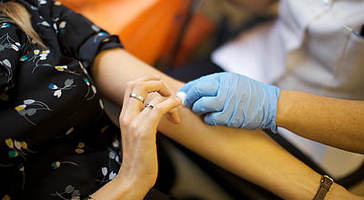
The sickle cell and thalassaemia (SCT) data collection and performance analysis report for 1 April 2016 to 31 March 2017 is out now.
The NHS Sickle Cell and Thalassaemia Screening Programme offers antenatal and newborn screening.
Antenatal screening identifies parents to be who are genetic carriers of an unusual form of haemoglobin so they can be offered counselling and prenatal diagnosis (PND).
If PND shows that the baby has inherited a sickle cell disease or thalassaemia, further counselling is offered to enable parents to make decisions regarding their pregnancy.
The screening programme offers the initial screening test by 10 weeks of pregnancy. Early screening is important as couples need to complete all the tests and have enough time to consider whether to continue with the pregnancy.
The NHS Newborn Blood Spot Screening Programme uses the heel prick test to detect babies with sickle cell disease so they can receive prompt treatment. This procedure also identifies babies who are genetic carriers for sickle cell and babies with beta thalassaemia.
Babies who test positive are treated early, improving their health and, in some cases, preventing severe disability or even death.
The new report, published today, includes:
- screening data for the NHS Sickle Cell and Thalassaemia Screening Programme for the financial year 1 April 2016 to 31 March 2017
- screening performance against national programme standards
Main findings
Between 1 April 2016 and 31 March 2017, approximately 677,000 pregnant women were screened for sickle cell and thalassaemia, and approximately 667,500 newborn babies for sickle cell disease.
Coverage remains high in both antenatal and newborn screening.
The acceptable level of pregnant women having a screening result available by 10 weeks and 0 days gestation is met nationally. The median performance for this KPI is above the acceptable level in all regions except in London, but there is wide variation in performance.
While there was an improvement in the proportion of women tested by 10 weeks and 0 days, this does not appear to have had a positive impact on early PND testing.
The proportion of PND tests performed by 12 weeks and 6 days gestation remains at approximately 40%, compared to 50% in the year 2014 to 2015. This delay in screening can have a significant impact on people’s lives, as shown through the recently published parents’ stories.
There was a decline in the number of screen positives in London in both antenatal and newborn screening but rates remain steady in the rest of England.
Completion of the family origin questionnaire remains high in all regions.
The uptake of testing of the baby’s biological father continues to improve slightly nationally.
Just under 40% of newborn screen positives had no information provided for their age at first visit to a paediatrician, but of those that did have information approximately 90% were seen in clinic by 90 days of age. For comparison, data from the National Congenital Anomalies and Rare Disorders Registration Service indicates that 77.7% of affected babies were seen in clinic by 90 days.
We recognise the difficulties and challenges of collating and collecting this data, so a big thank you to all our data providers for their continued hard work in submitting data.
PHE Screening blogs
PHE Screening blogs provide up to date news from all NHS screening programmes. You can register to receive updates direct to your inbox, so there’s no need to keep checking for new blogs.